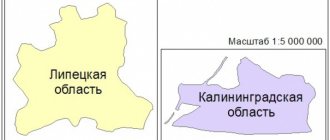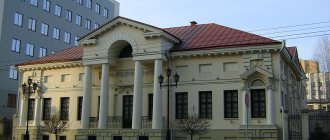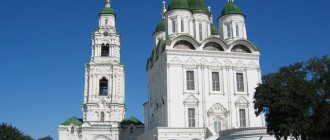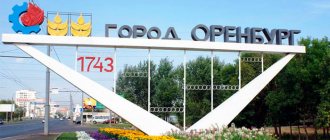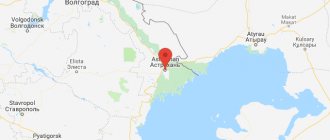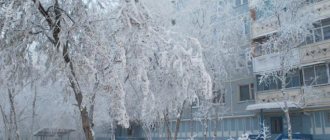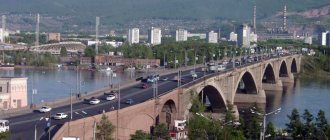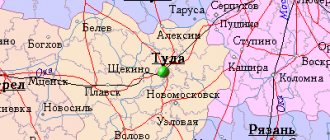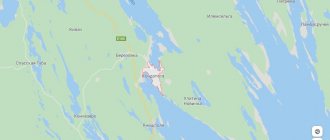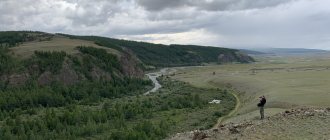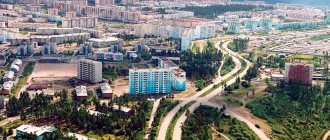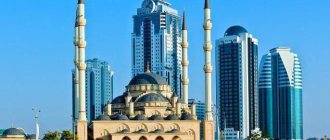| Population: 318,768 people. | City area: 122.00 km2 |
| Time zone:UTC +10 | Telephone code:+7 (4112) |
| Postal code:677 000 | Automotive region:14 |
| Cost of housing per m2: 74,876 rubles. | Average salary: RUB 65,568. |
Yakutsk is the largest city built in the permafrost zone. The city of Yakutsk is the capital of the Republic of Sakha (Yakutia) and the largest port on the Lena River. The city is famous for the contrast of summer and winter temperatures: in winter the thermometer sometimes drops to -65 °C, and on the hottest summer days it can rise to +39 °C. The amplitude of temperature fluctuations in other years exceeded 100 °C. This is due to the fact that the climate of Yakutsk is sharply continental.
Yakutsk on the map of Russia
Unfortunately, many Russians, especially those living in the Western European part of the country, still do not know where Yakutsk is located. It seems to them that Yakutia is a republic located somewhere outside the territory of Russia, somewhere beyond Mongolia or China. Let's dispel doubts. On the map of our vast country, Yakutsk is located in the northeast, on the left bank of the largest river in Eastern Siberia - the Lena.
Yakutsk coordinates: 62.03° north latitude, 129.73° east longitude. You can fly from Moscow to Yakutsk in 6.5 hours by plane, and the trip by car will take about one week.
Why is the city so named: Yakutsk, the capital of Sakha (Yakutia)
Among all the “cold” cities on our planet, Yakutsk occupies a special place - not a single settlement in the world experiences temperature fluctuations of 102 degrees Celsius. A city on “chicken legs” Just don’t think that Yakutsk consists entirely of huts on chicken legs, groaning and turning their backs to the direction of the world indicated by the unlucky traveler. However, the vast majority of Yakut houses actually stand on stilts. And the point here is not at all the originality of local architects. Just under the city there is 200 - 300 meters of permafrost, which in the upper layers is not “eternal”, but “seasonal”. In its usual - winter - state, permafrost is as strong as concrete, but disturb its temperature regime and the house floats. And in the literal sense of the word. This is why we need piles-legs that go 4-5 meters down into layers that never thaw, and a gap between the surface of the earth and the warm “belly” of the house. By the way, again due to the fault of permafrost, Yakutsk is also called “a city with guts out”: all heating mains go above ground.
The epic of Yakutsk, an outpost in Siberia, is curious. Back in 1632, a small detachment of servicemen led by a Cossack, Pyotr Beketov, on the right bank of the Lena, on the land of the Yakuts they set up the Lena fort, it was located below the existing Yakutsk, the chosen place was unsuccessful - low, and was subject to flooding. The prison had to be moved to the other side to Lake Saysary. The favorable location on the river arteries, and the route connecting Siberia and the East with the center of the country, all contributed to the development of the village into a large city, and the name comes from the lands of the people on which it was built.
Yakutsk is a port city located on the Lena River, the modern capital of Yakutia. The founding date of the city is considered to be 1632, and since 1643 Yakutsk has occupied its modern location. Its origin and development are directly related to the history of the development of the Far North. The place for the construction of the city was chosen by governor P.P. Golovin. The old fort was constantly subject to flooding and was often destroyed as a result, which raised the question of finding a more convenient place for the governor. After several unsuccessful attempts to move the fort, such a place was found. And new construction began on the left bank of the Lena River, which is quite high and therefore not subject to flooding, and also less accessible from a strategic point of view. The original name of the fort was Lensky, named after the river. After some time, due to the growth and development of the settlement, the fort was renamed the city of Yakutsk or Yakutsk, after the name of the people who had lived in this area for a long time. The city was built as a fortress made of wood, surrounding a castle, inside of which there were churches - the temple of the Life-Giving Trinity and the temple in the name of St. Mikhail Malein, as well as a guest courtyard, state storehouses, the governor's house and some other buildings. After a fire that occurred during the reign of Peter I, funds were allocated and craftsmen were appointed for the construction of stone buildings in the city. The first buildings made of stone were the Voivodeship Office, the Trinity Cathedral and the Church of the Presentation of the Virgin Mary. The defense of the city was provided by artillery. Until the beginning of the 19th century, development was carried out quite chaotically; there was no construction plan. The first clear construction plan appeared only during the reign of Alexander I. Modern Yakutsk is famous for its industry, including shipbuilding. The Yakut University and its museums are also famous, the most unusual of which is the Diamond Museum. e-reading.club
Population of Yakutsk
There is a misconception that only representatives of the small people of the North live in Yakutsk - they ride reindeer to work, live in yurts, and in the spring, as soon as it gets warmer, they begin to dig the soil in their garden beds in search of the next portion of diamonds.
And this, of course, is not true. Representatives of the city are quite ordinary citizens with their usual pressing problems.
The mayor of Yakutsk is currently Sardana Avksentieva.
According to the latest data, almost 319 thousand people live in the city of Yakutsk, of which 51.5% are women and 48.5% are men.
By national composition:
- 141 thousand Yakuts,
- 113 thousand Russians,
- 3.9 thousand Ukrainians,
- 3 thousand Kyrgyz,
- 2.8 thousand Evenks,
- 2.5 thousand Buryats,
- 2.3 thousand Armenians,
- 2.1 thousand Evens.
and many other nationalities. In this vein, Yakutsk is a multinational city.
Residents of Yakutsk are famous for their hospitality and broad soul. Every four years, the international Children of Asia Games are held here, where young athletes gather from all over our country and the entire eastern continent. Sport in Yakutia not only strengthens the spirit, but also teaches the younger generation friendship and respect.
The townspeople honor the traditions of their native Republic, proof of this is the annual national holiday Ysyakh - a bright holiday of welcoming summer.
In recent years, several world records have been broken during this holiday - “the most massive playing of the harp (khomus)”, “the most massive drinking of kumis”, “the largest round dance in the world”.
YAKUTSK
YAKUTSK, a city in Russia, the capital of the Republic of Sakha (Yakutia), the center of the urban district. Us. 323.0 thousand people (2019). Located in the Tuymaada valley, on the left bank of the river. Lena (port; ferry crossing Yakutsk - Nizhny Bestyakh), in the zone of permafrost distribution. Road junction. International Airport.
Story
Founded on September 25 (October 5), 1632, 70 km downstream of the Lena from modern. city by a detachment of Cossacks under command. P.I. Beketov as a prison “on the Lena River”. In 1634, it was moved by Ataman I.A. Galkin upstream of the river, and received the name. New Lensky fort (also called Yakutsk). Since 1638, the center of the Yakutsk region, military adm. and the North-East shopping center. Siberia, a stronghold for the development and study of the Far East (including Kamchatka expeditions). In 1643, by order of the governor P.P. Golovin (from the Golovin family), it was transferred to the present. the place where the center of Yakut settlements was located. From that time on it was called only the Yakut fort (or Y.). In 1681–84 it was displaced in relation to the fort of the 1640s, in 1686–87 it was expanded, and was badly damaged by a fire in 1701 (gradually destroyed, partially demolished, by 1901 one tower remained, which burned down in 2002; rebuilt in 2004). From ser. 17th century Yakutia is the center of the Yakut exile, one of the largest in Russia. state and Ros. empires. Among those exiled to Ya. are the Old Believers (since 1660), gr. A. G. Bestuzhev-Ryumina (1744–51), Decembrists [including A. A. Bestuzhev (Marlinsky) and Z. G. Chernyshev (from the Chernyshev family)], adherents of the Skoptchestvo, participants in the Polish uprising of 1863–64 , Narodniks, Narodnaya Volya, Social Democrats (G. I. Petrovsky, E. M. Yaroslavsky, etc.) and Socialist Revolutionaries (E. K. Breshko-Breshkovskaya, etc.). A district town in the Siberian province (1708–64, from 1724 in the Irkutsk province). In 1764–1805, as part of the Irkutsk province (in 1783–96 – Irkutsk governorship): a district (1764–1805), provincial (1775–83) and regional (1783–96) city. Adm. center (1805–1920), center of the commissariat (1805–22), district city (1822–1920) of the Yakut region. In 1895, regular steamship passenger service was opened along the river. Lena.
Sov. power was established on July 1, 1918. From 5/8/1918 to 14/12/1919 under the control of white troops. On the night of December 15, 1919, as a result of a bloodless coup, power in Yaroslavl passed to the local Military Revolutionary Committee. In March – June 1922, during the anti-Soviet rebellion in Yakutia, it was occupied by the detachments of the “Yakut People’s Army” of M. Ya. Korobeinikov. Adm. center and district city of the Yakut province (1920–22). The capital of the Yakut Autonomous Soviet Socialist Republic (1922–90), at the same time a district center (1922–30). In Vel. Otech. During the war, air control was located in Ya. Alsib highway (section Uelkal - Yakutsk - Krasnoyarsk), along which Lend-Lease aircraft were ferried from the USA to the USSR. The capital of the Yakut-Sakha SSR (1990–91), since 1991 - the Republic of Sakha (Yakutia). Since 2004, the center of the mountains. districts. In 2014, the labor movement on the railway was opened. line Tommot - Nizhny Bestyakh.
Architecture
The city was built up according to the regular plan of 1821. The Trinity Cathedral (1707–28; heavily rebuilt in the 20th century, restored since 2014), the wooden salt shop (1824) and shopping arcades (1828), the Transfiguration Cathedral (1838–45, rebuilt) have been preserved in the 1930s, restored in 1993–2001), Nikolskaya Ts. (1847–51), the Treasury building (1909) and the public library named after. A. S. Pushkin (1911; both with facades in the Russian style).
In the 1960s–80s, including according to the general plan of 1959, the Lena cinema was built (1965), ch. academic building of the university (1967), new microdistricts with buildings on pile foundations, etc. On the site of the Gostiny Dvor, 1st floor. 19th century (demolished in 1957) a center was formed. pl. Lenin with the building of the regional committee of the CPSU (1964–67, architect P. N. Mikhailov), the House of Soviets (1970–75, architect N. V. Sukhanov) and the monument to V. I. Lenin (1967, sculptor Yu. D. Struchkov ). Among the buildings 20 – beginning 21st centuries: Holy Protection women's monastery. (1998; Pokrovskaya ts., 1980), Center of the Yakuts. spirituality “Archi Diete” (2002), cathedral mosque (2005), wood. c. Savior Not Made by Hands (2011–12) Spassky male mon. (1663, closed in 1919, reopened in 2013), etc. Monuments to the first Komsomol members of Yakutia (1966, sculptor Yu. G. Neroda), E. M. Yaroslavsky (1969), heroes of Civil. wars of 1917–22 (1977), A. E. Kulakovsky (2002), P. I. Beketov (2007). Mine of the merchant F. Shergin (a well 116 m deep, dug in 1828–37 to observe permafrost).
Centers of science and culture
Among scientific institutions - Yakut. scientific Center of the Siberian Branch of the Russian Academy of Sciences (1949, current status since 1988), Yakut. scientific complex medical center problems (2002). Universities: North-East. Federal University named after M.K. Amosova [created in 2009 on the basis of Yakut. state University (1956)], Yakut. state agricultural Academy (1985), Higher School of Music (Institute) named after. V. A. Bosikova (1993, current name since 2012), Yakut. state technical engineer Institute (2000), Arctic State. Institute of Culture and Arts (2000), branches of Russia. universities Theological Seminary (1858). National Library of the Republic of Sakha (Yakutia) (1925), etc. Museums: State. United History and Culture of the Peoples of the North named after. Eat. Yaroslavsky [1887; 7 branches, including the House-Museum of Political History. links in Yakutia (1951)], Nat. artistic [dates back to 1927, it includes the Gallery of Foreign Art named after. M. F. Gabyshev (1970)], literary named after. P. A. Oyunsky (1970), khomus (1990; the only one in the world), music and folklore of the peoples of Yakutia (1990, since 1999). Ortho-Doidu Zoo (2001).
Yakut Opera and Ballet Theater (building 1982). Dramatic theaters: Sakha academic. them. P. A. Oyunsky (1906; building 2000), Russian named after. A. S. Pushkin (1920; building in the style of Soviet neoclassicism, 1954–57, architect I. N. Bondarev), Youth Theater (1990). Olonkho Theater (2008). National dance theater named after S. A. Zvereva - Kyyl Wala (1992). State Philharmonic Society (2011, since 2013 named after G. M. Krivoshapko), consisting of: symphony. orchestra “Symphonica ARTica” and string ensemble “Arco ARTico” (both 2012), brass band “Lena River Brass” and quintet “Sakha Brass” (both 2011), chamber ensemble “Camerata Yakutsk” (2013). Intl. festivals: musical Arctic “Northern Lights” (since 2011, annual), Christmas Arts Festival (since 2014, annual).
Sport
The development of sports infrastructure is facilitated by traditions. international "Children of Asia" competitions (since 1996, once every 4 years): the multifunctional stadium "Tuymaada", a stadium and an athletics stadium were built. arena "Youth", ice palace "Elley Bootur", Sports Palace "50 years of Victory", swimming pools "Dolgun", "Cholbon", National Center. sports "Modun" and others. Leading clubs of the city: mini-football "Zarya" (founded in 1997), football "Yakutia" (1991; disbanded in 2021). Ya. has repeatedly hosted the World Women's International Drafts Championship: in 1999, 2006–2007, 2021.
Farm
The largest trade and business center of the republic: there are a number of retail (turnover 20.8 billion rubles, 2015) and wholesale trade facilities, branches of Russian commercial banks and other service enterprises. Head offices and representative offices of companies for the production and transportation of hydrocarbons (Yakut Fuel and Energy Company, Sakhatransneftegaz, Surgutneftegaz), diamond cutting, production and sale of diamonds and jewelry [divisions, including production, of the EPL Diamond group of companies » – one of the largest producers of diamonds in Yakutia, including for export; the company "Choron Diamond", the enterprise "Komdragmetall of the Republic of Sakha (Yakutia)"], etc. Technopark "Yakutia" (among the residents are innovative companies working in the field of information and biotechnologies, construction, etc.). Of great importance is the production of building materials (Sahabazalt, Yakutsk Plant of Building Materials and Structures, House-Building Plant) and metalworking (Metal Structures Plant, etc.), as well as the food and flavoring industry (Yakutsk Poultry Factory, Yakutsk City Dairy Plant) , bakery, etc.). Within the city district - “Yakut gas processing plant; natural gas preparation), brown coal mining (Kangalassky open-pit mine), Kangalassy industrial park (production of polyethylene pipes, metal structures, paint and varnish products, long-burning solid fuel boilers and other products for the needs of construction, housing and communal services, and the agricultural sector) . State district power station (1970; 368 MW), State district power station-2 (2016; 170 MW; both in the structure), thermal power plant (12 MW).
Sports objects
In Yakutsk there is a large and excellently equipped ice palace, which is called “Elley Bootur”. There are also several stadiums with artificial turf. Among them are “Tuymaada” and “Youth”. Sports sections for children and adults operate in the sports palace “50 Years of Victory”, as well as at the sports complexes “Triumph”, “Sterkh”, “Dolgun”, “Nugget”, “Tandem”, “Modun” and “Cholbon”.
Circus and zoo
The Republic of Yakutia (the capital is Yakutsk) has been pursuing a policy for more than one year under the motto “All the best for children,” as the authorities understand how important it is to provide the most comfortable conditions for their young citizens, who, due to harsh weather conditions, are deprived of many entertainments available to their peers from other countries. regions. In particular, for them, the only Diamond Circus in the Arctic operates in the capital, the troupe of which constantly employs more than 60 artists.
A favorite place to visit for Yakut children is also the Orto-Doidu Zoo - the only one in the world that operates in extreme cold conditions. There you can see not only animals living in the region, but also “guests” from Africa, North and South America and Australia. In addition, the zoo has a department where they are ready to receive and treat any wild animal in trouble.
Yakut churches and cathedrals
In the capital of the Sakha Republic, people of different religions have long lived side by side. Therefore, the city has churches of several faiths at once. At the same time, representatives of the indigenous population have the opportunity to follow their historical religious traditions.
Transfiguration Cathedral
- Opening hours: daily, from 8:30 to 19:00.
- Address: st. Kirova, 3. Transport stop "Art Museum".
The oldest surviving city church was built with the money of the wealthy merchants, the Solovyov brothers, and consecrated in 1838. The five-domed church with gilded domes, a refectory topped with three onions, is a remarkable example of the pseudo-Russian style in religious architecture. It has a two-tier bell tower with high arched windows, covered with a high conical tent. In the 30s of the last century, the temple was closed, and the building was used as a library. Only 60 years later the cathedral was returned to the believers. After restoration completed in 2001, it looks great.
St. Nicholas Church
- Opening hours: daily, from 8:00 to 19:00.
- Address: st. Oktyabrskaya, 31. Transport stop "Oktyabrskaya".
Of all the churches in Yakutsk, only this church managed to preserve its original appearance unchanged, and, oddly enough, we have the CPSU to thank for this. It was precisely because party archives were kept in the building after the revolution that it was kept in perfect order. Of course, the painting on the walls and dome was destroyed, but otherwise the temple was almost undamaged. Therefore, today the townspeople and guests of Yakutsk see the church exactly as it was in the middle of the 19th century.
Archa's house
- Opening hours: on weekdays, from 9:00 to 18:00.
- Telephone.
- Address: st. Chernyshevsky, 24. Transport stop "Art Museum".
Many indigenous people of the Sakha Republic honor ancient traditions and adhere to the beliefs of their ancestors. In the spiritual center of the Archy House, they have the opportunity to participate in rituals and religious holidays, and constantly feel involved in the national culture. In addition to religious events, folklore festivals and exhibitions of works by masters of decorative and applied arts are held here. The building of the center looks surprisingly colorful. Its exterior displays characteristic national motifs. Sacred totems are installed in front of the entrance to the center.
Monuments
The capital of Yakutia, Sakha, whose photos will decorate your travel album, will also be of interest to lovers of monuments and sculptural compositions. In particular, there you can see a unique statue of a mammoth, which was installed in the courtyard of the Institute of Permafrost Science, on the site where the well-preserved corpse of this animal was found. Another image of a prehistoric relative of modern elephants is located next to the new building of the Yakut circus. Moreover, on the back of the mammoth there are two gilded acrobats. In addition, in the capital of the republic you can see a monument to friendship, depicting the first family created by a Russian and a Yakut woman, and their mixed-breed baby. Like all citizens of the former USSR, residents of Yakutia took part in the defense of their great Motherland during the Second World War. In memory of those who never returned from the battlefield, the Victory Stele was erected.
Museums
The Republic of Sakha (Yakutia) (capital - Yakutsk) has a distinctive culture. To get to know it, it’s worth visiting local museums. There are just under a dozen of them, but there you can see unique examples of decorative and applied art of the republic. For example, magnificent collections are presented in the United Museum of History and Culture of the Peoples of the North and in the Museum of Hummus Music.
When is it celebrated?
Yakutsk City Day is celebrated annually in early autumn. It is celebrated on the 2nd Sunday of September. Thus, the date may fall on different dates between September 8th and 14th in different years.
In 2019, the holiday is held on September 8th.
In addition to City Day, Yakutsk also annually celebrates the founding day of the Republic on April 27th.
Figure 1. Mass celebrations, photo from the press service of the local administration
Basic information
The Republic of Sakha (Yakutia), or, as it was then called, the Yakut Autonomous Soviet Socialist Republic, was formed in the first years after the establishment of Soviet power in the region. It is the largest administrative-territorial unit, but in terms of population density it occupies one of the last places in the Russian Federation. At the same time, its land is incredibly rich in natural resources, which, if used correctly, can become the source of a real breakthrough in the economic sphere of the republic.
Yakutia borders the Chukotka Autonomous Okrug, Magadan, Irkutsk and Amur regions, Khabarovsk, Krasnoyarsk and Transbaikal territories. In addition, in the north its shores are washed by the East Siberian Sea and the Laptev Sea.
Popular message topics
- Bone lace
Bone lace is usually called bone carving, which belongs to folk crafts. This type of creativity has been known for a long time, it is especially popular among residents of the north. Bone carving has a long history. The first products were simple, - Austria
Austria is a small country located in the middle of Europe. The population is 7,600,000 people. Small area of approximately 84,000 sq. km. The capital of this state is Vienna. Austria is called the Austrian Republic. It was created 1918, - Nature of the Samara Territory
The Samara Territory is located on the Volga River. The vegetation of the Samara region is truly unique. There are many forests here. Oak is very common. Oak forests occupy the largest area among all forests in the Samara region.
Program of events and its features
Every year the holiday is held under a certain motto. In 2018, the slogan was: “Yakutsk is a city of innovation and new opportunities!”
Each celebration is unique, but is built on unchanging principles. Fairs, festivals, sports competitions and competitions, ceremonial rallies, performances of creative groups, etc. are held.
Attention is always paid to local national motifs: ethnographic exhibitions, festivals, and ensemble performances are organized. Yakutsk is a multinational settlement, but the Yakut population is almost 50%. Lots of mixed families. Among the native townspeople, the majority have both Russian and local roots. Therefore, Yakut culture here is popular and respected by all residents.
In 2021, sports competitions, library and museum events, grand openings of new city facilities, and an exhibition and fair of local goods are planned.
Among the festive events: an ethnographic festival, a performance by the vocal association “Kyyray” and the dance ensemble “Komus Kuun”, other folklore and modern groups and ensembles.
Figure 2. Festive concert
A festive prayer service is also held in the Gradoyakut Transfiguration Cathedral with a religious procession to the monument to the founder of Yakutsk - Pyotr Beketov - followed by the laying of flowers to it by citizens and officials.
In the evening, after sunset, it is time for fireworks and a color and music show.
Fireworks in honor of the holiday
In general, the holiday is always very colorful, eventful and interesting not only for city residents, but also for visitors. The full list of events becomes known a month before the celebration; it is published on the official website of the city and in local newspapers.
History of Yakutsk (briefly)
In 1643, the Lensky fort, founded by centurion Pyotr Beketov 20 years earlier, was moved to the territory of the modern city. At the same time, it was renamed Yakutsk, and also proclaimed the administrative center of the entire Lena region. Despite this, for a long time the city more closely resembled a large settlement, and its development began only in 1907, when, by a personal royal decree, I. Kraft was appointed governor there. By his order, the capital of Yakutia was electrified and telephoned, and the first museum was opened there.
Famous natives and residents of the city
Hero of the Soviet Union Guard Major Nikolai Nikolaevich Chusovskoy. Battalion commander in the Great Patriotic War. He took part in the Berlin operation. Signed on the walls of the Reichstag.
Hero of the Russian Federation Guards Junior Lieutenant Vitaly Neff. He died during the Georgian aggression in Tskhinvali on August 10, 2008, while carrying a wounded colleague from under fire.
Corresponding Member of the Russian Academy of Sciences Viktor Aksenov, Soviet and Russian physicist.
Doctor of Medical Sciences, Professor, Academician of the Russian Academy of Medical Sciences and Russian Academy of Sciences Yuri Shevchenko. Outstanding cardiologist.
Honored Artist of Russia ballerina Zhanna Bogoroditskaya, now holds the position of teacher-tutor of the Kremlin Ballet.
